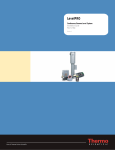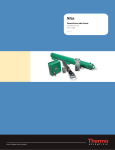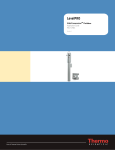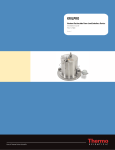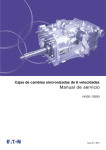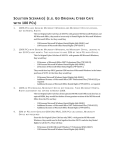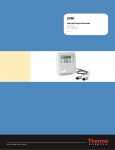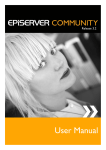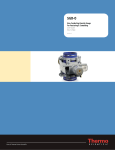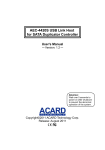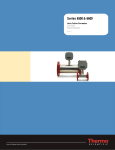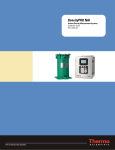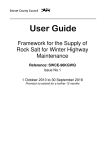Download Instruction Manual - Gilson Engineering Sales Inc.
Transcript
LevelPRO Continuous Gamma Level System Installation Guide P/N 717760 Revision B Part of Thermo Fisher Scientific LevelPRO Continuous Gamma Level System Installation Guide P/N 717760 Revision C © 2007 Thermo Fisher Scientific Inc. All rights reserved. “HART” is a registered trademark of the HART Communication Foundation. All other trademarks are the property of Thermo Fisher Scientific Inc. and its subsidiaries. Thermo Fisher Scientific Inc. (Thermo Fisher) makes every effort to ensure the accuracy and completeness of this manual. However, we cannot be responsible for errors, omissions, or any loss of data as the result of errors or omissions. Thermo Fisher reserves the right to make changes to the manual or improvements to the product at any time without notice. The material in this manual is proprietary and cannot be reproduced in any form without expressed written consent from Thermo Fisher. This page intentionally left blank. Revision History Thermo Fisher Scientific Revision Level Date Comments 1.0 03-99 Initial release. 2.0 08-01 Revised per ECO 7570. A 02-06 Revised per ECO 5101. B 10-07 Revised per ECO 6000. C 08-08 Revised per ECO 6540. LevelPRO Installation Guide v This page intentionally left blank. Contents Safety Information & Guidelines ..................................................................... ix Safety Considerations .............................................................................ix Warnings, Cautions, & Notes ................................................................ix Chapter 1 Product Overview ............................................................................................. 1-1 Associated Documentation.................................................................. 1-1 Chapter 2 Handling & Storage .......................................................................................... 2-1 ESD Procedures .................................................................................. 2-1 Unpacking, Inspection, & Storage ...................................................... 2-2 Packing, Shipping, Transporting, & Receiving.................................... 2-2 Chapter 3 Hardware Installation...................................................................................... 3-1 Licensing............................................................................................. 3-1 Source-Detector Configurations.......................................................... 3-2 Guidelines........................................................................................... 3-2 General ............................................................................................ 3-2 Power Requirements ........................................................................ 3-3 Detector-Transmitter .......................................................................... 3-4 Alignment ........................................................................................ 3-4 Measurable Range ............................................................................ 3-6 Top of Range ................................................................................ 3-6 Bottom of Range........................................................................... 3-6 The Source.......................................................................................... 3-8 Fan Source Guidelines...................................................................... 3-8 Strip Source Guidelines.................................................................... 3-9 Shutter Actuator............................................................................... 3-9 Multiple Detectors and / or Source Heads......................................... 3-10 Overview............................................................................................. 4-1 Chapter 4 Wiring.................................................................................................................. 4-1 Preparation.......................................................................................... 4-1 Wiring Drawings ............................................................................. 4-2 General Procedure............................................................................... 4-2 CPU Board ......................................................................................... 4-3 System Configuration ...................................................................... 4-3 Power Supply ...................................................................................... 4-4 DC Power ........................................................................................ 4-5 Thermo Fisher Scientific LevelPRO Installation Guide vii Contents Optional AC Power ......................................................................... 4-5 Relays............................................................................................ 4-6 Serial Communications ....................................................................... 4-6 RS485 Wiring.................................................................................. 4-6 Initial Setup for Party-Line Communications................................ 4-7 RS232 Wiring.................................................................................. 4-7 Using Serial Communications.......................................................... 4-7 HART Communications..................................................................... 4-8 Contact Closure Inputs ....................................................................... 4-8 Current Output .................................................................................. 4-8 Cascade Mode Wiring......................................................................... 4-9 Auxiliary Input Wiring...................................................................... 4-10 Chapter 5 Service & Support .............................................................................................5-1 Getting Help....................................................................................... 5-1 Warranty............................................................................................. 5-1 Appendix A Ordering Information .......................................................................................A-1 Appendix B Specifications...................................................................................................B-1 Appendix C Drawings............................................................................................................ C-1 Index ..........................................................................................................INDEX-1 viii LevelPRO Installation Guide Thermo Fisher Scientific Safety Information & Guidelines This section contains information that must be read and understood by all persons installing, using, or maintaining this equipment. Safety Considerations Failure to follow appropriate safety procedures or inappropriate use of the equipment described in this manual can lead to equipment damage or injury to personnel. Any person working with or on the equipment described in this manual is required to evaluate all functions and operations for potential safety hazards before commencing work. Appropriate precautions must be taken as necessary to prevent potential damage to equipment or injury to personnel. The information in this manual is designed to aid personnel to correctly and safely install, operate, and / or maintain the system described; however, personnel are still responsible for considering all actions and procedures for potential hazards or conditions that may not have been anticipated in the written procedures. If a procedure cannot be performed safely, it must not be performed until appropriate actions can be taken to ensure the safety of the equipment and personnel. The procedures in this manual are not designed to replace or supersede required or common sense safety practices. All safety warnings listed in any documentation applicable to equipment and parts used in or with the system described in this manual must be read and understood prior to working on or with any part of the system. Failure to correctly perform the instructions and procedures in this manual or other documents pertaining to this system can result in equipment malfunction, equipment damage, and / or injury to personnel. Warnings, arnings, Cautions, & Notes Warnings, cautions, and notes are used throughout this manual to alert users to potential hazards or important information. Failure to heed the warnings and cautions in this manual can lead to injury or equipment damage. Warning Warnings notify users of procedures, practices, conditions, etc. which may result in injury or death if not carefully observed or followed. The triangular icon displayed with a warning varies depending on the type of hazard (general, electrical, radiation). ▲ Thermo Fisher Scientific LevelPRO Installation Guide ix Caution Cautions notify users of operating procedures, practices, conditions, etc. which may result in equipment damage if not carefully observed or followed. ▲ Note Notes emphasize important or essential information or a statement of company policy regarding an operating procedure, practice, condition, etc. ▲ Tip Tips may also be used in this manual. They are suggestions or things to consider that will help you use the instrument or this manual. ▲ x LevelPRO Installation Guide Thermo Fisher Scientific Chapter 1 Product Overview Refer to the LevelPRO user guide for descriptions of instrument functions and features. Associated Documentation Thermo Fisher Scientific In addition to this guide, the following documents must be read and understood by all persons installing, using, or maintaining this equipment: ● LevelPRO user guide (P/N 717778) ● Gamma Radiation Safety (P/N 717904) LevelPRO Installation Guide 1-1 This page intentionally left blank. Chapter 2 Handling & Storage This chapter addresses procedures for handling electrostatic discharge (ESD) sensitive equipment, as well as procedures for unpacking, inspecting, and storing of the system. Caution This system is an ESD sensitive instrument. Use proper ESD protective equipment and procedures. Failure to comply with ESD procedures can result in circuit damage. ▲ ESD SD Procedures The instrument contains electronic components that can be damaged from discharges of static electricity: Do not touch the circuit board components. Ordinarily, handling the circuit boards by their edges will not damage the circuits. Observe the following when installing, setting up, servicing, troubleshooting, or repairing the instrument: 1. Use an antistatic bag. Most instrument subassemblies are shipped in a special antistatic bag. When not installed, keep the assembly in the bag as often as possible. 2. Remove ESD sensitive subassemblies only under the following conditions: a. When at a designated static-free workstation or when the bag is grounded at a field site. b. After the conductive area of the container has been neutralized. c. After making firm contact with an antistatic mat and / or firmly gripping a grounded individual. 3. Personnel handling ESD sensitive devices should be neutralized to a static-free workstation by means of a grounding wrist strap that is connected to the station or to a good grounding point at the field site. 4. Do not allow clothing to make contact with ESD sensitive devices. Thermo Fisher Scientific LevelPRO Installation Guide 2-1 Handling & Storage Unpacking, Inspection, & Storage 5. Avoid touching edge connectors and components. 6. Avoid partially connecting ESD sensitive devices. These devices, especially the power supply connector, can be damaged by floating leads. 7. Ground test equipment. 8. Avoid static charges during troubleshooting. Unpacking, cking, Inspection, & Storage Note Inspection, adjustment, installation, and maintenance of the instrument must be performed by experienced personnel only. ▲ 1. Upon receipt, inspect the instrument for damage that may have occurred while in transit. If there is evidence of rough handling or damage, file a damage claim with the transportation company immediately. Notify Thermo Fisher and / or your sales representative as soon as possible. 2. Carefully inspect the packing material prior to discarding it to ensure that all equipment and instruction paperwork has been removed. 3. Use the original packing material and container for storage if necessary. 4. If storing the instrument, the storage environment should be protected, free from extremes of temperatures and high humidity, and fall within the environmental constraints listed in the specifications. Packing, Shipping, Transporting, & Receiving 2-2 LevelPRO Installation Guide All personnel involved in the packing, shipping, or receiving of hazardous material must be trained in accordance with the United States Department of Transportation (DOT) and OSHA hazardous materials regulations or in accordance with the Canadian Nuclear Safety Commission (CNSC) regulations. Thermo Fisher Scientific Chapter 3 Hardware Installation Read the Gamma Radiation Safety Guide (P/N 717904) PRIOR TO installing the equipment. Tip Copies of the drawings referenced in this manual are provided in Appendix C. ▲ For detector-transmitter housing layout details, refer to drawing 868502. For mounting dimensions, refer to drawing 868672 or 868674 for watercooled units. A variety of source housings are used with the scintillation detector depending on the requirements of the application. Refer to the appropriate drawing for your source. Licensing icensing Warning The instrument is a nuclear device regulated by federal and / or state authorities. You are responsible for knowing and following the pertinent safety and regulatory requirements. Refer to the Gamma Radiation Safety Guide (P/N 717904) for a summary of these requirements. ▲ Warning Moving or removing an installed source housing or any assembly that includes a source housing requires a person who is specifically licensed to install and commission Thermo Scientific source heads. ▲ In the United States, your general license permits you to own and install all of the instrument’s components, including the source head. However, you may not commission the instrument (remove the lock and open the source housing shutter for the first time) without a specific license authorizing radiation commissioning of the instrument. In Canada, you are only allowed to remove the instrument from the shipping container if your CNSC license has a condition authorizing mounting / dismounting of devices. For assistance obtaining a license and / or commissioning / decommissioning the instrument, contact Thermo Fisher. Thermo Fisher Scientific LevelPRO Installation Guide 3-1 Hardware Installation Source-Detector Configurations Source-Detector Configurations The gauge is comprised of one or more source heads and one or more detector-transmitter units. Source heads are available in a point source or strip source configuration. Point sources have a fan-shaped beam, and for most point sources, the beam angle spreads at a 45° angle in the vertical dimensions (30° angle for the Model 5210). Strips sources emit radiation evenly along the length of the vessel from the source and measure the radiation level reaching the detector after passing through the vessel walls and the process material. The scintillation detector is available in lengths ranging from 1 to 12 feet, in 1-foot increments. For a tall or narrow tank, multiple sources and / or detectors might be required. The specific source head / detector configuration depends on the application. Three possible configurations are illustrated below. Figure 3–1. Guidelines Warning Do not install the system in any hazardous area other than those approved. Refer to the equipment tag for the specific approvals applicable to the configuration of your instrument. ▲ Warning Do not apply power to the instrument in any hazardous area unless the safety ground is properly wired inside the instrument and the cover is properly installed. ▲ Instrument approvals are listed in Appendix B. General eneral Review the following guidelines when planning gauge installation: 1. Correct power source is available. See “Power Requirements” later in this chapter. 2. You will need to supply the necessary brackets and hardware required for mounting the gauge to the vessel. 3-2 LevelPRO Installation Guide Thermo Fisher Scientific Hardware Installation Guidelines 3. Operating temperature range: -40°C to +60°C (-40°F to +140°F). 4. There should be enough clearance to install and service the source and detector-transmitter. Refer to the appropriate drawings for your type of gauge and mount. 5. Position the source housing so the radioactive source identification tag is visible. Mount it so the tag is upright. 6. The gauge should not be mounted where process overflow or other material can collect in the beam path. The source shutter mechanism must be kept free of debris. 7. If the handheld terminal will be used for configuration, the connection must be located in a safe area. 8. There should be enough clearance to install and service the source and the detector. Refer to the dimensional drawings in the drawing appendix. Power Requirements Thermo Fisher Scientific Ensure the correct power source is available. One of the following input power sources is required: 24 Vdc ± 20% or 115/230 Vac ± 15%, 50/60 Hz (requires optional AC power board). The maximum power requirement is 12 VA. Both DC and AC power may be supplied to the gauge at the same time. The gauge will draw power from whichever input source provides the higher DC source voltage. LevelPRO Installation Guide 3-3 Hardware Installation Detector-Transmitter Detector-Transmitter Warning Do not install the system in any hazardous area other than those approved. Refer to the equipment tag for the specific approvals applicable to the configuration of your instrument. ▲ Warning Do not apply power to the instrument in any hazardous area unless the safety ground is properly wired inside the instrument and the cover is properly installed. ▲ Warning For hazardous location installations, the cable entries must be sealed per the installation layout drawing (868502). ▲ Warning For non-hazardous location installations, the enclosure cable entries must be sealed with a compound to protect against the passage of gas or vapors. The sealing compound should not be affected by the surrounding atmosphere or liquids. The sealing compound must have a thickness of at least 5/8 inch (16 mm). ▲ Warning Use proper lifting procedures during installation to avoid injury. Refer to drawings 868672 or 868674 (water-cooled units) for weights and dimensions of the detector housing. ▲ Alignment nment Refer to drawings 868502 and 868672 (868674 for water-cooled units) for mounting dimensions of the detector-transmitter. The source housing and detector are normally installed across the diameter of the vessel. If mechanisms internal to the process vessel would interrupt the radiation beam, you can move the installation slightly off center. Contact Thermo Fisher if the angle between the source and detector will be less than 130°, as illustrated below. Figure 3–2. 3-4 LevelPRO Installation Guide Thermo Fisher Scientific Hardware Installation Detector-Transmitter It is important to mount the gauge head securely, since any movement or change in alignment can affect the gauge’s calibration. When mounting the source, be sure to include a means of aiming the beam several degrees left or right so the source beam can be aligned with the detector. The exact mounting method will vary depending on the application. Align the center of the source beam path as closely as possible with the centerline of the detector housing. The source beam is narrow horizontally, and the radiation is uniform only in the primary (center) part of the beam. The shielding in the source housing attenuates the radiation in the secondary part of the beam. The sensitive area of the detector is the center 2-7/8 inches (73 mm) across the width of the detector’s housing. This area should lie entirely within the primary beam. Figure 3–3. To determine the primary beam width, you will need the included angle of the beam, which is typically approximately 12°. For each degree, the beam will be 1 unit wide for every 60 units from the source. For example, if the include angle is 12°, the primary beam width will be 12 inches wide 60 inches away from the source head. At 120 inches from the source head, the beam width will be 24 inches, and so on. This is illustrated in the figure below. Figure 3–4. Determining primary beam width Thermo Fisher Scientific LevelPRO Installation Guide 3-5 Hardware Installation Detector-Transmitter Measurable Range Before beginning the installation, verify that the measurable range (the range over which the process level can be measured) of the proposed installation meets the requirements of your application. The top and bottom of the measurement range depend on the source type (fan or strip), the detector length, and the position of the source relative to the detector’s sensitive length. Sensitive length refers to the part of the detector that senses radiation. Tip The sensitive length of the detector is approximately the length from the upper mounting bolt to the lower mounting bolt. ▲ Top of Range For a fan source, the top of the range is at the top of the sensitive length of the detector or at the center of the source housing, whichever is lower. For a strip source, the top of the range is at the top of the sensitive length of the detector or at the top of the active length of the source, whichever is lower. Bottom of Range For a fan source, the bottom of range is the point where a line drawn from the fan source to the detector centerline at the bottom end of the detector’s sensitive length intersects the inner vessel wall nearest the detector. This is illustrated in Figure 3–5. Tip If the vertical beam width of the source does not fully illuminate the sensitive length of the detector, the bottom of the range is the point at which the lower limit of the source beam intersects the inner vessel wall. ▲ For a strip source, the bottom of the range is at the bottom of the detector’s sensitive length or at the bottom of the active length of the source, whichever is higher. In Figure 3–5, the top of the source beam (center of the source housing) is aligned with the top of the sensitive length of the detector. Thus, the top of the measurable range is defined by the horizontal line drawn from the top of the sensitive length of the detector to the center of the source housing. The bottom of the range (BR), measured from the top of the measurable range, is provided by the formula: BR = BD − [PD × BD ÷ SD], or, equivalently, BR = BD × [1 − (PD ÷ SD)], (continued) 3-6 LevelPRO Installation Guide Thermo Fisher Scientific Hardware Installation Detector-Transmitter where BD = distance from top of range to the bottom of the sensitive length of the detector (in Figure 3–4, BD = sensitive length of detector). PD = distance from the center of the detector to the inner vessel wall. SD = distance from the center of the detector to the center of the source. Figure 3–5. Scintillation detector with point source (fan beam) Thermo Fisher Scientific LevelPRO Installation Guide 3-7 Hardware Installation The Source The Source Warning In the United States, you may uncrate and mount the source housing, but you may not remove the shipping bolt unless you are licensed to commission the gauge. In Canada, you must have a license condition permitting mounting / dismounting, and without this condition, users may not remove the source from the shipping crate. ▲ Warning Use proper lifting procedures to avoid injury. ▲ The scintillation detector can be used with either a fan source or a strip source. Normally the scintillation detector is mounted so that the top of the detector’s sensitive length is even with the top of the fan beam or even with the top of the active length of the strip source. Fann Source Guidelines Note the following if using a fan source. 1. The vertical angle of the fan source beam is typically 45°. This means that the beam’s vertical range is equal to the horizontal distance between the detector and the source. (In special cases, the angle may be 30° or 60°. Contact Thermo Fisher for guidance.) 2. Mount the source so that the top of the fan beam is aligned with the top of the sensitive length of the detector. 3. Install the source housing with its mounting face as close to the process vessel as practical, with no structural material (mounting tabs, brackets, etc.) between the beam area and the vessel. 4. The mounting should ensure accurate beam alignment with the detector and provide for easy left-right angular adjustment. The top of the beam should be even with the top of the measurable range. 3-8 LevelPRO Installation Guide Thermo Fisher Scientific Hardware Installation The Source Strip Source Guidelines Note the following if using a strip source. 1. Refer to the source housing drawings to determine the position of the active length of the strip source and other mounting dimensions. 2. Secure the housing with the 1/2-inch (12 mm) bolts and lock washers (six places). The housing mounting face allows clearance for bolts or studs extending up to 2-1/4 inches (57 mm) from the mounting surface. 3. For best results, the measurable range should be less than the active length of the strip source(s). Position the strip source so that the bottom of the active length of the source is even with the minimum level to be measured. If the measurable range must be greater than the active length of the strip source, position the top of the active length of the source so that it is even with the maximum level to be measured. 4. The mounting surface should be vertical. The mounting should ensure accurate beam alignment with the detector and provide for easy leftright angular adjustment. 5. Install the source housing with its mounting face as close to the vessel as practical, with no structural material (mounting tabs, brackets, etc.) between the beam area and the vessel. Shutter Actuator Thermo Fisher Scientific If your source housing includes a pneumatic shutter actuator, refer to drawing 866664 for installation details. LevelPRO Installation Guide 3-9 Hardware Installation Multiple Detectors and / or Source Heads Multiple Detectors and / or Source Heads Certain applications may require the use of multiple detectors and / or multiple source heads to span the desired measurable range. If multiple detectors are used, the uppermost unit should be mounted so that the top of its sensitive length is even with the top of the measurable range. The remaining units should be mounted so that the top of each detector’s sensitive length is aligned with or slightly overlaps the bottom of the sensitive length of the detector mounted just above it. If more than one source head is required, the top source housing should be installed with the top of its beam even with the top of the desired measurable range. The other source housings should be spaced evenly along the vertical dimension of the vessel. For example, if the range of interest is 12 feet and three fan beam sources are used, the source housings should be spaced four feet apart. The installation / arrangement drawings provide mounting dimensions for several fan source-detector configurations (refer to drawings 868566 through 868571). When mounting two or more pairs of strip sources and detectors on a small diameter tank, adjacent pairs of sources and detectors may be rotated by 90° if necessary. The source and detector for each source-detector pair at the same height must still be mounted on opposite sides of the tank (180°). After mounting the uppermost source-detector pair, the position of the source and detector in the next lower pair may be rotated by 90° and so on. 3-10 LevelPRO Installation Guide Thermo Fisher Scientific Chapter 4 Wiring Overview erview Wiring should be performed in the following order: 1. Power to the gauge 2. Remote computer terminal or handheld terminal to the gauge via the serial communication ports 3. Optional wiring: a. 4–20 mA current output b. Relay contacts c. Contact closure inputs d. Remote display e. Auxiliary 4–20 mA current input f. Wiring to cascade multiple units Preparation Review the following carefully prior to connecting any wiring. Warning Remove all power from the unit before making any connections. Electrocution can result if power is present. ▲ Warning All wiring must be done by qualified individuals in accordance with applicable codes such as the NEC (National Electric Code) ANSI / NFPA 70 specifications or the Canadian Electrical Code Part 1. ▲ Warning Do not apply power to the unit in any hazardous area unless the safety ground is properly wired inside the unit and the cover is properly installed. ▲ Warning For hazardous location installations, the cable entries must be sealed per the installation layout drawing (868502). ▲ Thermo Fisher Scientific LevelPRO Installation Guide 4-1 Wiring General Procedure Warning For non-hazardous location installations, the cable entries into the enclosure must be sealed with a compound to protect against the passage of gas or vapors. The sealing compound should not be affected by the surrounding atmosphere or liquids. The sealing compound must have a thickness of at least 5/8 inch (16 mm). ▲ Warning If metal conduit is used, the conduit must be grounded. ▲ Warning Connect the AC wiring earth ground to the internal safety ground terminal, as shown in the wiring diagram. Refer to “Optional AC Power” later in this chapter to change the AC supply voltage. ▲ Wiring iring Drawings The installation layout drawing (868502) provides general guidance for routing the cables to the unit. The installation wiring drawing (868503) shows the function of each connector pin on the CPU board and optional AC power / relay board. In addition, the drawing shows cable requirements for connecting the sensor to the transmitter, power requirements, and grounding locations. The label on the top of the detector-transmitter chassis also shows connector pin information for wiring the power boards, including the relay contacts, the contact closure inputs, and the current output. Drawing 868519 provides additional instructions for wiring the RS485 and RS232 serial port connectors. General Procedure Follow this general procedure to access the detector electronics for wiring. 1. Ensure all source shutters are in the OFF position. 2. Ensure all power to the gauge is turned off. 3. Remove the housing access cover by loosening the screw on the cover retaining bracket and sliding the bracket off of the housing cover. Unscrew the housing access cover. Two lugs on the top of the cover aid with removal. 4-2 LevelPRO Installation Guide Thermo Fisher Scientific Wiring CPU Board 4. Remove the cable conduit plugs from the hole(s) that will be used. As shown in the installation layout drawing (868502), lay one conduit for the DC power input and signal cables and a second conduit for the AC power input and relays, if applicable. Route the cables into the detector housing and connect input power and signal wires as shown in the wiring drawing (868503). 5. Pull each cable through the correct conduit fitting and into the enclosure. Leave approximately 6 inches (150 mm) for strain relief. Secure the conduit, making sure it is completely sealed. 6. Continue through the remaining sections in this chapter for wiring instructions specific to the power supply, serial and HART® communications, etc. 7. When the wiring is complete, replace the detector housing cover, and secure the cover retaining bracket. CPU Board The CPU board is the system’s main board. The gauge is shipped from the factory with all CPU board jumpers configured properly for your system configuration. Should you need to replace the CPU board, note the jumper settings for connectors J7 (current output configuration) and J11 (system configuration) before replacing the board. After installing the new board, verify that the jumpers are set properly for your system configuration. Figure 4–1 shows the location of connectors and jumpers. System stem Configuration J11 on the CPU board is the connector for system configuration jumpers. Move the jumper at pins 5 and 6 to pins 4 and 5 to enable the CPU to recognize optional relays mounted on the power supply board. Later units will be shipped with the jumper already at pins 4 and 5, even if the relay option is not purchased. Move the jumper to pins 1 and 8 of the J11 connector to erase system memory. Caution Placing a jumper across pins 1 and 8 on the J11 connector erases system memory. All user-entered parameters are erased and reset to factory defaults. ▲ Thermo Fisher Scientific LevelPRO Installation Guide 4-3 Wiring Power Supply If you are going to erase memory by placing a jumper across pins 1 and 8, first remove power from the detector-transmitter. Note the location of the jumpers on the J11 connector. Place a jumper across pins 1 and 8, apply power, and leave power on for approximately 30 seconds to erase memory. Remove power and restore the configuration jumpers to their original settings. Figure 4–1. Connectors and jumpers on the CPU board Power Supply The system is designed to operate on 24 Vdc. If the optional AC power board is installed, the system can also operate on 115 or 230 Vac (± 15%), 50/60 Hz. The maximum input power requirement is 12 VA. If both AC and DC power are supplied to the detector, the detector will draw power from whichever source provides the higher DC voltage. The maximum length of the cable that can be used to supply power varies depending on the wire gauge. Refer to the wiring drawing (868503) for cable information and other wiring details. Warning All wiring must be done by qualified individuals in accordance with applicable codes such as the NEC (National Electric Code) ANSI / NFPA 70 specifications or the Canadian Electrical Code Part 1. For intrinsically safe systems, refer to ANSI / ISA RP 12.6. ▲ 4-4 LevelPRO Installation Guide Thermo Fisher Scientific Wiring Power Supply Note To meet the requirements of CSA 1010.1, an external switch or circuit breaker must be installed to allow the power source to be disconnected from the gauge. In addition, protective bonding (grounding) must always be provided, even if DC power is used. ▲ DC Power J12 on the CPU board is the connector for the DC source voltage wiring. Refer to the wiring drawing (868503) and to the table below for connections. Table 4–1. DC power connections Power Supply J12 on CPU Board Positive (+) J12-2 Negative (-) J12-1 Note To meet the requirements of CSA 1010.1, the input DC terminals must be supplied from a SELV (Safety Extra Low Voltage) source. ▲ Optional ptional AC Power If the optional AC power board is installed, the gauge may be operated using 115 or 230 Vac. The AC selector switch is shown in the figure below. Caution Applying 230 Vac with the selector switch in the 115 Vac position will damage the equipment. ▲ J9 on the CPU board is the connector for the AC power supply, and J17 on the AC power supply is the wiring connector. Refer to the wiring drawing (868503) and to the figure below. Figure 4–2. AC power supply board Thermo Fisher Scientific LevelPRO Installation Guide 4-5 Wiring Serial Communications Caution For reliable operation and to maintain safety approval, the F1 fuse on the AC power board must only be replaced with an approved fuse. ▲ Warning Remove all power from the unit before making any connections. Electrocution can result if power is present. ▲ Relays The AC power supply can be purchased with two relays. Relay contacts are Form C SPDT, isolated 8 A, 220 Vac. The relays can be configured to open or close on events or faults or with level measurement. Refer to the LevelPRO user manual for instructions. Refer to the wiring drawing (868503) and the label inside the transmitter cover for wiring details. Serial Communications The gauge provides one RS232 single drop and one RS485 multi-drop serial interface. Screw terminal connectors for both ports are located at J3 on the CPU board. The RS485 connector includes the +8 Vdc required to power the Thermo Scientific 9734 handheld terminal (HHT) as well as the +DATA and –DATA connections. An RJ11 (phone jack) connector is also provided for the RS485 port at J4 on the CPU board. The HHT can be connected directly to the RJ11 connector in safe areas. Both ports provide independent access to the measurement readings and software functions. They are always active and can be used to display measurements. The setup menus, however, may only be accessed by one port at a time. RS485 S485 Wiring Connecting the serial (COM) port on a PC to the RS485 port on the gauge requires a RS485 / RS232 converter (P/N OTO515D). 1. Connect J3-12 (+DATA) and J3-11 (–DATA) to the corresponding connections on the RS485 / RS232 converter. 2. Connect the converter to the PC using the supplied DB9 serial cable. 3. Refer to drawings 868519 and 868503 for additional details. 4-6 LevelPRO Installation Guide Thermo Fisher Scientific Wiring Serial Communications Initial Setup for PartyLine Communications To communicate with multiple gauges via a RS485 party-line, each unit must be assigned a unique unit identification number so it can be addressed individually. All gauges are assigned unit number 0 (zero) by default. To assign a unique unit number to each gauge, you must be able to communicate with each one individually. Disconnect each gauge from the party-line in turn and communicate with the disconnected gauge directly. Alternately, you can remove power from all gauges except one and assign a unit number to the powered gauge. If you have trouble using another device on the RS485 chain, verify that it is properly terminated for its position on the chain. To terminate a device, connect a 120-ohm resistor between its RS485 + / - data terminals. Never terminate more than the first and last device in the chain. RS232 Wiring The serial port on a PC (COM1 or COM2) can be connected directly to the RS232 port on the gauge. This requires five wires: ground, transmit (TX), receive (RX), request-to-send (RTS), and clear-to-send (CTS). The connections between the RS232 port (J3 on the CPU board) and the PC serial port are summarized in the table below for standard DB9 and DB25 PC serial port connectors. Table 4–1. Using Serial Communications J3 on CPU Board PC Serial Port DB9 Connector PC Serial Port DB25 Connector J3-2 (RX) Pin 3 Pin 2 J3-3 (TX) Pin 2 Pin 3 J3-4 (RTS) Pin 8 Pin 5 J3-5 (CTS) Pin 7 Pin 4 J3-6 (GND) Pin 5 Pin 7 To communicate with the gauge from a PC requires that the PC be running a terminal emulation software. The default communication settings for the gauge’s RS485 and RS232 ports and for the HHT are: 7 data bits, Even parity, 1 stop bit, 9600 baud. Refer to the LevelPRO user guide for additional details about setting up and using serial communications. Thermo Fisher Scientific LevelPRO Installation Guide 4-7 Wiring HART Communications HART Communications The HART® communication protocol is supported over the 4–20 mA current output with the HART interface board. The HART interface board is an optional daughter board that is wired via a cable to J6 on the CPU board. Communication with the gauge is via the 275 or 375 Field Communicator from Emerson Electric Co. Refer to the LevelPRO HART operation manual (P/N 717817) for detailed instructions. Tip HART communication protocol allows you to configure and calibrate the gauge in most applications; however, due to limitations of the protocol, the complete range of functions are only available when using the Thermo Scientific Model 9734 handheld terminal and the RS485 port. ▲ Contact Closure Inputs The contact closure inputs are dry contact inputs between ground and Switch 1 and ground and Switch 2 at J13 on the CPU board. The gauge can be configured via software settings to execute a command or other function upon a user-provided contact opening or closing. Refer to the LevelPRO user manual for instructions on assigning commands to the contact closure inputs. When operating in “cascade” mode, where multiple units are wired together to act as a single detector, contact closure Switch 2 is dedicated to performing the cascading function. Refer to drawings 868503 and 868529. Current Output Following are the configurations available for the 4–20 mA current output: ● Isolated, loop-powered (default) ● Non-isolated, self-powered ● Isolated, self-powered output (requires optional piggyback board P/N 886595) The isolated, loop-powered or non-isolated, self-powered configurations can drive a 700 ohm maximum load over the full current output range. The isolated, self-powered current output can drive a maximum load of 1000 ohms. The current output is programmable between 0 and 20 mA. The operational range of the output current is 3.8–20.5 mA. The fault low condition for the current output is 3.6 mA or less, and the fault high condition is 20.8 mA or greater. 4-8 LevelPRO Installation Guide Thermo Fisher Scientific Wiring Cascade Mode Wiring The default current output configuration is isolated, loop-powered. A jumper is placed across pins 4 and 5 of the J7 connector on the CPU board. For this configuration, pins 6 and 7 of the J10 connector are for the 4–20 mA output connections. Figure 4–3. 4–20 mA loop powered configuration To configure the current output as non-isolated, self-powered, move the jumper to pins 3 and 4 of the J7 connector. For this configuration, pins 6 and 9 of the J10 connector are for the 4–20 mA output connections. Figure 4–4. 4–20 mA non-isolated, self-powered configuration To configure the current output as isolated, self-powered, a piggy-back board must be installed on the J7 connector (no jumpers used). For this configuration, pins 6 and 8 of the J10 connector are for the 4–20 mA output connections. Cascade Mode Wiring For applications requiring a detector length greater than twelve feet, multiple units can be wired together to act as one continuous detector. In this situation, the last unit in the line is referred to as the primary unit. All wiring for the serial ports, relays, etc. is done in the primary unit. Remaining units are referred to as secondary units. All secondary units must be powered in the same manner as the primary unit (either AC or DC). Each secondary unit must be wired such that the cascade “out” from one goes into the cascade “in” of the next unit in line. These totaled signals are accumulated in the primary unit, which outputs the actual level indication. All programming for secondary units must be set at default conditions for the cascade to work properly. Refer to drawings 868503 and 868529 in the drawing appendix for the wiring requirements. Thermo Fisher Scientific LevelPRO Installation Guide 4-9 Wiring Auxiliary Input Wiring Auxiliary Input Wiring 4-10 LevelPRO Installation Guide There is an auxiliary connection on connector J10 for applications requiring an outside 4–20 mA signal be input into the LevelPRO and used as a form of compensation adjustment (vapor density, pressure, etc.). The outside 4–20 mA signal should be wired so that the positive connection of the loop is connected at J10 pin 1 and the negative side connected to J10 pin 2. The special equation is then utilized to incorporate this input into the LevelPRO program. Refer to the LevelPRO user guide for information on special equations. Thermo Fisher Scientific Chapter 5 Service & Support Getting Help The local representative is your first contact for support and is well equipped to answer questions and provide application assistance. You can also obtain support by contacting Thermo Fisher directly. In the United States Thermo Fisher Scientific 1410 Gillingham Lane Sugar Land, TX 77478 Phone: 713-272-0404 Fax: 713-272-2272 In Europe Thermo Fisher Scientific Ion Path Road Three Winsford Cheshire CW7 3GA United Kingdom Phone: +44 (0) 1606 548700 Warranty In Canada Thermo Fisher Scientific 14 Gormley Industrial Avenue Gormley, Ontario L0H 1G0 Phone: 905-888-8808 Fax: 905-888-8828 On the Web www.thermo.com Thermo Scientific products are warranted to be free from defects in material and workmanship at the time of shipment and for one year thereafter. Any claimed defects in Thermo Scientific products must be reported within the warranty period. Thermo Fisher Scientific Inc. (Thermo Fisher) shall have the right to inspect such products at Buyer’s plant or to require Buyer to return such products to Thermo Fisher plant. In the event Thermo Fisher requests return of its products, Buyer shall ship with transportation charges paid by the Buyer to Thermo Fisher plant. Shipment of repaired or replacement goods from Thermo Fisher plant shall be F.O.B. Thermo Fisher plant. A quotation of proposed work will be sent to the customer. Thermo Fisher shall be liable only to replace or repair, at its option, free of charge, products which are found by Thermo Fisher to be defective in material or workmanship, and which are reported to Thermo Thermo Fisher Scientific LevelPRO Installation Guide 5-1 Service & Support Warranty Fisher within the warranty period as provided above. This right to replacement shall be Buyer’s exclusive remedy against Thermo Fisher. Thermo Fisher shall not be liable for labor charges or other losses or damages of any kind or description, including but not limited to, incidental, special or consequential damages caused by defective products. This warranty shall be void if recommendations provided by Thermo Fisher or its Sales Representatives are not followed concerning methods of operation, usage and storage or exposure to harsh conditions. Materials and / or products furnished to Thermo Fisher by other suppliers shall carry no warranty except such suppliers’ warranties as to materials and workmanship. Thermo Fisher disclaims all warranties, expressed or implied, with respect to such products. EXCEPT AS OTHERWISE AGREED TO IN WRITING BY Thermo Fisher, THE WARRANTIES GIVEN ABOVE ARE IN LIEU OF ALL OTHER WARRANTIES, EXPRESSED OR IMPLIED, AND Thermo Fisher HEREBY DISCLAIMS ALL OTHER WARRANTIES, INCLUDING THOSE OF MERCHANTABILITY AND FITNESS FOR PURPOSE. 5-2 LevelPRO Installation Guide Thermo Fisher Scientific Appendix A Ordering Information A complete LevelPRO system consists of up to four integrated detectortransmitters, any number of sources as applicable to the application, and a type of communication. Table A–1. System ordering information Thermo Fisher Scientific Code Model LPRO LevelPRO integrated continuous nuclear / gamma level system Code Detector-Transmitter Enclosure Type S Carbon steel detector housing W Water-cooled jacketed steel detector housing Code First Detector-Transmitter Length* 01 1 ft detector 02 2 ft detector 04 4 ft detector 06 6 ft detector 08 8 ft detector 10 10 ft detector 12 12 ft detector Code Second Detector-Transmitter Length (optional)* XX XX ft detector (same lengths available as first detector-transmitter) Code Third Detector-Transmitter Length (optional)* XX XX ft detector (same lengths available as first detector-transmitter) Code Fourth Detector-Transmitter Length (optional)* XX XX ft detector (same lengths available as first detector-transmitter) Code Input Power A 115 Vac B 24 Vdc C 230 Vac LevelPRO Installation Guide A-1 Ordering Information System ordering information, cont. Code Relay Output N No relay R Two SPDT relays Code 4–20 mA Output Type L Isolated, loop-powered S Isolated, self-powered N Non-isolated, self-powered Code Communications 0 No selection A 9734 HHT RS485 cable B 9734 HHT RS485 & RS232 cable C RS485 / RS232 converter E HART communication module Code Accessories (optional) S Sm SS tag (0.75 x 2.5 in), wired L Lg SS tag (3.3 x 2.5 in), wired R RJ11 modular connector jack D Model 9723 backlit LCD A 3/4-in NPT to metric adapter *Detector-transmitter lengths available in odd increments (3 ft, 5, ft, etc.) as a special order. Contact Thermo Fisher for details. Table A–2. Spare parts Part Number Description 88670-1 CPU board 886592 Detector board 886595-1 ISO-24 piggyback board. Supports isolated, self-powered current output. 886568-1 AC power board, no relays. 886568-2 AC power board, 2 relays. 868568-3 Board with 2 relays, no AC power. AC power board fuse, F1 (LittelFuse 313.125), 250V, 0.125A (1/8A), Type T (SB), Size 3AG. A-2 LevelPRO Installation Guide Thermo Fisher Scientific Appendix B Specifications Results may vary under different operating conditions. Table B–1. Performance specifications System Performance 0.5% of span, typical Table B–2. Gamma ray source Source Type Cs-137 or Co-60, both stainless steel doubly encapsulated Size 10–10,000 mCi Cs-137 or 1,000–2,000 mCi Co-60 (source size dependent upon application) Source Housing Carbon steel, lead filled, polyurethane painted (stainless steel also available) Two-position shutter, locks in OFF (closed) position 30°, 45°, and 60° beam angle source housings available (beam angle is dependent upon application) Table B–3. Integrated detector-transmitter Thermo Fisher Scientific System Architecture Multiprocessor based electronics provides uninterrupted output during data entry and system interrogation Surface mount technology provides high degree of reliability All user data is doubly stored in non-volatile memory with no battery backup required Detection Type PVT plastic scintillator with wide dynamic range; PVT resists shock and moisture damage Detector Lengths Standard detector lengths in 2-ft increments, up to 12 ft* Multiple detectors can be wired together for large measurement spans. Power 115/230 Vac ±10%; 50/60 Hz or 24 Vdc available Surge protected 9–35 Vdc Operating Temperature -40°C to +60°C (-40°F to +140°F), ambient LevelPRO Installation Guide B-1 Specifications Integrated detector-transmitter, cont. Enclosure Construction Carbon steel polyurethane painted Optional water-cooled detector for higher temperature applications Approvals FMRC approved Class I, Div. 1, Groups B, C, & D; dust-ignition proof in Class II, Div. 1, Groups E, F, & G; suitable for Class III, Div. 1 hazardous locations; indoor and outdoor NEMA 4 CSA approved Class I, Div. 1, Groups B, C, & D; dust-ignition proof in Class II, Div. 1, Groups E, F, & G; suitable for Class III, Div. 1 hazardous locations; indoor and outdoor CSA ENCL 4 Intertek ATEX approved II 2 G Ex d IIC T6 IP66 CE Mark *Detector-transmitter lengths available in odd increments (3 ft, 5, ft, etc.) as a special order. Contact Thermo Fisher for details. Table B–4. Outputs / Inputs Current Outputs Standard: 4–20 mA isolated, loop-powered into 800 ohms, field scalable Optional: 4–20 mA isolated, self-powered into 800 ohms, field scalable Optional: 4–20 mA non-isolated, self-powered into 800 ohms, field scalable Serial Outputs RS485 half-duplex, RS232 full duplex Contact Closure Outputs 2X 115 Vac / 28 Vdc SPDT at 10 A (230 Vac SPDT at 8 A) Inputs Signal from another LevelPRO detector; additional input for gas density compensation or buildup available Dry contact closure Table B–5. Mounting Hardware B-2 LevelPRO Installation Guide Integrated detector-transmitter Integral bolt-on bracket Gamma ray source Integral bolt-on bracket Thermo Fisher Scientific Specifications Table B–6. Local remote display Model 9723 2-line x 16-character backlit LCD Hazardous enclosure is FMRC and CSA approved for Class I, Div. 1, Groups E, F, & G; Class III, Div. 1, hazardous locations. FMRC approved NEMA 4 and CSA TYPE 4 Display powered from electronics Maximum separation from electronics: 300 ft (91.4 m) Table B–7. Programming Thermo Fisher Scientific 375 Field Communicator For setting up and calibrating the gauge and for entering data. Communicates with any LevelPRO via the current loop. BEL202FSK standard Handheld Terminal (Model 9734) For setting up and calibrating the gauge and for entering data. Communicates with any LevelPRO via RS485 connector. Provides upload / download of gauge configuration to / from PC via RS232 interface. Comm PC Interface Software For interfacing with up to 32 LevelPRO units over RS485; RS485 / RS232 converter provided LevelPRO Installation Guide B-3 This page intentionally left blank. Appendix C Drawings Note Information presented in this chapter has been regenerated from original drawings. Every effort is made to maintain document accuracy. However, in order to enhance legibility, the documents may have been restructured and some information may have been intentionally excluded. Therefore, the drawings within this manual may not be exact duplicates of the original drawings. ▲ Note Drawings in this manual are included for reference only and may not be the current version. Contact the factory if you need a copy of the latest revision. ▲ Table C–1. Wiring Drawing Rev. Description Page 868503 E Installation wiring – LevelPRO Model 9740A-X (3 sheets) C–3 868519 B RS485 installation & wiring (1 sheet) C–6 868529 A Multiple detectors cascade wiring, Models 9742/4/6 (1 sheet) C–7 867627 C Installation drawing – Local / remote display, Model 9723 (1 sheet) C–8 Table C–2. Mechanical Thermo Fisher Scientific Drawing Rev. Description Page 868502 C Installation layout – LevelPRO Model 9740A-X (1 sheet) C–9 868672 B Mounting dimensions – LevelPRO Model 9740A-X (1 sheet) C–10 868674 A Mounting dimensions – LevelPRO water-cooled Model 9740AX (1 sheet) C–11 868568 B LevelPRO installation / arrangement drawing – 1 source with 1 detector (2 sheets) C–12 868569 B LevelPRO installation / arrangement drawing –2 sources with 1 detector (2 sheets) C–14 868566 B LevelPRO installation / arrangement drawing – 3 sources with 1 detector (2 sheets) C–16 868567 B LevelPRO installation / arrangement drawing – 2 sources with 2 detectors (2 sheets) C–18 LevelPRO Installation Guide C-1 Drawings Drawing Rev. Description Page 868570 B LevelPRO installation / arrangement drawing – 2 sources with 3 detectors (2 sheets) C–20 868571 B LevelPRO installation / arrangement drawing – 3 sources with 2 detectors (2 sheets) C–22 Table C–3. Source housings Drawing Rev. Description Page 865494 C Mounting dimensions – Model 5205 / 5205A source housing, 100 mCi (1 sheet) C–24 865504 B Mounting dimensions – Model 5206 source housing, 500 mCi (1 sheet) C–25 865514 C Mounting dimensions – Model 5207 source housing, 2000 mCi (1 sheet) C–26 865524 D Mounting dimensions – Model 5208 source housing, 8000 mCi (1 sheet) C–27 866891 A Mounting dimensions – Model 5210 source housing, 10 Ci Cs-137, 3 Ci Co-60 (1 sheet) C–28 868628 B Mounting dimensions – Model 5205B source housing (1 sheet) C–29 868629 B Mounting dimensions – Model 5206B source housing (1 sheet) C–30 868630 B Mounting dimensions – Model 5207B source housing (1 sheet) C–31 868631 C Mounting dimensions – Model 5208B source housing (1 sheet) C–32 860463 B Mounting dimensions – Model 5194 strip source, 1 ft., 500 mCi (1 sheet) C–33 860473 C Mounting dimensions – Model 5195 strip source, 2 ft., 1000 mCi (1 sheet) C–34 860483 C Mounting dimensions – Model 5196 strip source, 3 ft., 1000 mCi (1 sheet) C–35 4 Table C–4. Source housing options Drawing Rev. Description Page 866764 -- Interlock option for Models 5205–5208 source heads (1 sheet) C–36 866664 B Pneumatic actuator and position switch for Models 5205–5208 (1 sheet) C–37 867269 B Mounting instructions – Remote manual actuator for Models 5205–5208 (2 sheets) C–38 Table C–5. Other C-2 LevelPRO Installation Guide Drawing Rev. Description Page 868709 B HART retrofit, LevelPRO (1 sheet) C–40 Thermo Fisher Scientific Drawings Figure C–1. 868503: Installation wiring – LevelPRO Model 9740A-X (sheet 1 of 3) Thermo Fisher Scientific LevelPRO Installation Guide C-3 Drawings Figure C–2. 868503: Installation wiring – LevelPRO Model 9740A-X (sheet 2 of 3) C-4 LevelPRO Installation Guide Thermo Fisher Scientific Drawings Figure C–3. 868503: Installation wiring – LevelPRO Model 9740A-X (sheet 3 of 3) Thermo Fisher Scientific LevelPRO Installation Guide C-5 Drawings Figure C–4. 868519: RS485 installation & wiring (sheet 1 of 1) C-6 LevelPRO Installation Guide Thermo Fisher Scientific Drawings Figure C–5. 868529: Multiple detectors cascade wiring, Models 9742/4/6 (sheet 1 of 1) Thermo Fisher Scientific LevelPRO Installation Guide C-7 Drawings Figure C–6. 867627: Installation drawing – Local / remote display, Model 9723 (sheet 1 of 1) C-8 LevelPRO Installation Guide Thermo Fisher Scientific Drawings Figure C–7. 868502: Installation layout – LevelPRO Model 9740A-X (sheet 1 of 1) Thermo Fisher Scientific LevelPRO Installation Guide C-9 Drawings Figure C–8. 868672: Mounting dimensions – LevelPRO Model 9740A-X (sheet 1 of 1) C-10 LevelPRO Installation Guide Thermo Fisher Scientific Drawings Figure C–9. 868674: Mounting dimensions – LevelPRO water-cooled Model 9740A-X (sheet 1 of 1) Thermo Fisher Scientific LevelPRO Installation Guide C-11 Drawings Figure C–10. 868568: LevelPRO installation / arrangement drawing – 1 source with 1 detector (sheet 1 of 2) C-12 LevelPRO Installation Guide Thermo Fisher Scientific Drawings Figure C–11. 868568: LevelPRO installation / arrangement drawing – 1 source with 1 detector (sheet 2 of 2) Thermo Fisher Scientific LevelPRO Installation Guide C-13 Drawings Figure C–12. 868569: LevelPRO installation / arrangement drawing – 2 sources with 1 detector (sheet 1 of 2) C-14 LevelPRO Installation Guide Thermo Fisher Scientific Drawings Figure C–13. 868569: LevelPRO installation / arrangement drawing – 2 sources with 1 detector (sheet 2 of 2) Thermo Fisher Scientific LevelPRO Installation Guide C-15 Drawings Figure C–14. 868566: LevelPRO installation / arrangement drawing – 3 sources with 1 detector (sheet 1 of 2) C-16 LevelPRO Installation Guide Thermo Fisher Scientific Drawings Figure C–15. 868566: LevelPRO installation / arrangement drawing – 3 sources with 1 detector (sheet 2 of 2) Thermo Fisher Scientific LevelPRO Installation Guide C-17 Drawings Figure C–16. 868567: LevelPRO installation / arrangement drawing – 2 sources with 2 detectors (sheet 1 of 2) C-18 LevelPRO Installation Guide Thermo Fisher Scientific Drawings Figure C–17. 868567: LevelPRO installation / arrangement drawing – 2 sources with 2 detectors (sheet 2 of 2) Thermo Fisher Scientific LevelPRO Installation Guide C-19 Drawings Figure C–18. 868570: LevelPRO installation / arrangement drawing – 2 sources with 3 detectors (sheet 1 of 2) C-20 LevelPRO Installation Guide Thermo Fisher Scientific Drawings Figure C–19. 868570: LevelPRO installation / arrangement drawing – 2 sources with 3 detectors (sheet 2 of 2) Thermo Fisher Scientific LevelPRO Installation Guide C-21 Drawings Figure C–20. 868571: LevelPRO installation / arrangement drawing – 3 sources with 2 detectors (sheet 1 of 2) C-22 LevelPRO Installation Guide Thermo Fisher Scientific Drawings Figure C–21. 868571: LevelPRO installation / arrangement drawing – 3 sources with 2 detectors (sheet 2 of 2) Thermo Fisher Scientific LevelPRO Installation Guide C-23 Drawings Figure C–22. 865494: Mounting dimensions – Model 5205 / 5205A source housing, 100 mCi (sheet 1 of 1) C-24 LevelPRO Installation Guide Thermo Fisher Scientific Drawings Figure C–23. 865504: Mounting dimensions – Model 5206 source housing, 500 mCi (sheet 1 of 1) Thermo Fisher Scientific LevelPRO Installation Guide C-25 Drawings Figure C–24. 865514: Mounting dimensions – Model 5207 source housing, 2000 mCi (sheet 1 of 1) C-26 LevelPRO Installation Guide Thermo Fisher Scientific Drawings Figure C–25. 865524: Mounting dimensions – Model 5208 source housing, 8000 mCi (sheet 1 of 1) Thermo Fisher Scientific LevelPRO Installation Guide C-27 Drawings Figure C–26. 866891: Mounting dimensions – Model 5210 source housing, 10 Ci Cs-137, 3 Ci Co-60 (sheet 1 of 1) C-28 LevelPRO Installation Guide Thermo Fisher Scientific Drawings Figure C–27. 868628: Mounting dimensions – Model 5205B source housing (sheet 1 of 1) Thermo Fisher Scientific LevelPRO Installation Guide C-29 Drawings Figure C–28. 868629: Mounting dimensions – Model 5206B source housing (sheet 1 of 1) C-30 LevelPRO Installation Guide Thermo Fisher Scientific Drawings Figure C–29. 868630: Mounting dimensions – Model 5207B source housing (sheet 1 of 1) Thermo Fisher Scientific LevelPRO Installation Guide C-31 Drawings Figure C–30. 868631: Mounting dimensions – Model 5208B source housing (sheet 1 of 1) C-32 LevelPRO Installation Guide Thermo Fisher Scientific Drawings Figure C–31. 860463: Mounting dimensions – Model 5194 strip source, 1 ft, 500 mCi (sheet 1 of 1) Thermo Fisher Scientific LevelPRO Installation Guide C-33 Drawings Figure C–32. 860473: Mounting dimensions – Model 5195 strip source, 2 ft, 1000 mCi (sheet 1 of 1) C-34 LevelPRO Installation Guide Thermo Fisher Scientific Drawings Figure C–33. 860483: Mounting dimensions – Model 5196 strip source, 3 ft, 1000 mCi (sheet 1 of 1) Thermo Fisher Scientific LevelPRO Installation Guide C-35 Drawings Figure C–34. 866764: Interlock option for Models 5205–5208 source heads (sheet 1 of 1) C-36 LevelPRO Installation Guide Thermo Fisher Scientific Drawings Figure C–35. 866664: Models 5205–5208 pneumatic actuator and position switch (sheet 1 of 1) Thermo Fisher Scientific LevelPRO Installation Guide C-37 Drawings Figure C–36. 867269: Mounting instructions, remote manual actuator, Models 5205–5208 (sheet 1 of 2) C-38 LevelPRO Installation Guide Thermo Fisher Scientific Drawings Figure C–37. 867269: Mounting instructions, remote manual actuator, Models 5205–5208 (sheet 2 of 2) Thermo Fisher Scientific LevelPRO Installation Guide C-39 Drawings Figure C–38. 868709: HART retrofit, LevelPRO C-40 LevelPRO Installation Guide Thermo Fisher Scientific Index A ATEX, B-2 C Canadian Nuclear Safety Commission (CNSC), 2-2, 3-1 Canadian Standards Association (CSA), 4-5, B-2 cascade mode, 4-8, 4-9 CNSC. See Canadian Nuclear Safety Commission. commissioning, 3-1, 3-8 communication handheld terminal, 3-3, 4-6, 4-7, B-3 HART, 4-8, B-3 RS232 wiring, 4-7 RS485, 4-6, C-1 party-line, 4-7 configuration contact closure inputs, 4-8 CPU jumpers, 4-4 of current output, 4-8–4-9 source types. See source head. source-detector, 3-2–3-3 connectors AC power supply board, 4-5 CPU board, 4-4 contact information, 5-1 CPU board contact closure inputs, 4-8 jumper settings, 4-4 CSA. See Canadian Standards Association. D Department of Transportation (DOT), 2-2 detector-transmitter cascade mode, 4-8, 4-9, C-1 drawings, C-1 general wiring procedure, 4-2 installation, 3-4–3-7 Thermo Fisher Scientific installations with multiple, 3-10 ordering information, A-1–A-2 specifications, B-1 to source configuration, 3-2–3-3 DOT. See Department of Transportation. E electrostatic discharge (ESD), 2-1 ESD. See electrostatic discharge. F fan source, 3-2. Also see source head. determining measurable range, 3-6–3-7 installation guidelines, 3-8 H handheld terminal (HHT), 3-3, 4-6, 4-7, B-3 handling the instrument, 2-2 HART, 4-8, B-3, C-40 HHT. See handheld terminal. I inputs auxiliary current, 4-10 contact closure, 4-8, B-2 installation drawings, C-1–C-39 guidelines, 3-2 of detector-transmitter, 3-4–3-7 of source, 3-8–3-9 with multiple detectors or source heads, 3-10 installing drawings, C-1–C-39 guidelines for, 3-2 multiple detectors or source heads, 3-10 the detector-transmitter, 3-4–3-7 the source, 3-8–3-9 LevelPRO Installation Guide INDEX-1 Index J jumper settings CPU configuration, 4-4 erasing system memory, 4-4 L licensing, 3-1, 3-8 M mounting, 3-8–3-9, C-1 O ordering information, A-1–A-2 OSHA, 2-2 outputs current, 4-8–4-9, A-2, B-2 P point source. See fan source. power, A-1, B-1 requirements, 3-3 supply wiring, 4-4–4-6 AC option, 4-5 DC power, 4-5 R receiving the instrument, 2-2 relays, 4-6, A-2 RS232, 4-7 RS485, 4-6, C-1 party-line, 4-7 S safety, ix–x, 3-1, 3-2 scintillation detector. See detector-transmitter. serial communication, 4-6–4-7 shipping the instrument, 2-2 source head beam alignment, 3-4 INDEX-2 LevelPRO Installation Guide drawings, C-1–C-2 fan source, 3-2 determining measurable range, 3-6–3-7 installation guidelines, 3-8 general wiring procedure, 4-2 ordering information, A-1–A-2 specifications, B-1 strip source determining measurable range, 3-6–3-7 installation guidelines, 3-9 strip source, 3-2 to detector configuration, 3-2–3-3 source heads installations with multiple, 3-10 spare parts, A-2 specifications, B-1–B-3 storage of the instrument, 2-2 storing the instrument, 2-2 strip source, 3-2. Also see source head. determining measurable range, 3-6–3-7 installation guidelines, 3-9 T transmitter. See detector-transmitter. U unpacking the instrument, 2-2 W wiring, 4-1–4-10 auxiliary current input, 4-10 cascade mode, 4-9 current output, 4-8–4-9 drawings, 4-2, C-1 general procedure, 4-2 HART communication, 4-8 power, 4-4 AC option, 4-5 DC, 4-5 relays, 4-6 serial communication, 4-6–4-7 Thermo Fisher Scientific Thermo Fisher Scientific 81 Wyman Street P.O. Box 9046 Waltham, Massachusetts 02454-9046 United States www.thermofisher.com























































































